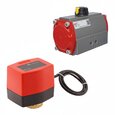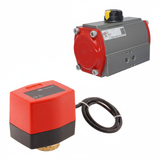What is an Actuator?
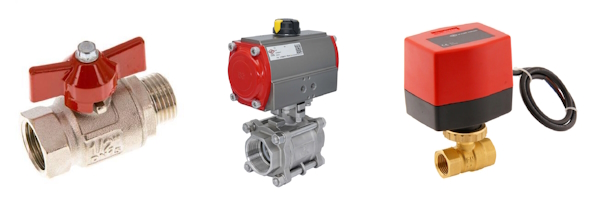
Figure 1: Mechanical (left), pneumatic (center), and electric (right actuators.
An actuator is a device that receives an energy input and converts it into motion or force and is an essential component in many modern technologies and engineering fields. From robotics to renewable energy, actuators play a critical role in controlling and automating various processes and systems. They come in many different forms and types, each with unique capabilities and uses.
Table of contents
Check out our selection of valve actuators!
Different types of actuators
Actuators come in various forms, and each type serves a specific purpose depending on the application. Two main categories define actuators: the type of movement and the power source.
Actuator movement type
Actuators can be categorized based on their movement type, either linear or rotary. Linear actuators produce linear motion in a straight line, while rotary actuators produce rotary motion in a circular path.
Linear actuators
- Linear actuators move objects along a straight line and use a belt and pulley, rack and pinion, or ball screw to convert electric motor rotation into linear motion.
- Linear actuators stop at a fixed linear distance and are known for their high repeatability and positioning accuracy, easy installation and operation, low maintenance, and ability to withstand harsh environments.
- These actuators are commonly used in food processing, automotive, material handling, and more for tasks like pushing, pulling, lifting, and positioning.
Rotary actuators
- Rotary actuators convert energy into rotary motion through a shaft to control equipment speed, position, and rotation.
- These actuators have a continuous rotational motor and are versatile in usage.
- An electric motor is a rotary actuator powered by an electric signal. They have high torque, constant torque during full angle rotation, compatibility with different diameters, hollow shafts with zero backlash, twice the output, low maintenance, and can achieve any degree of rotation.
- Rotary actuators are used in medical equipment, radar and monitoring systems, robotics, flight simulators, the semiconductor industry, special machine manufacturing, and defense.
Actuator power sources
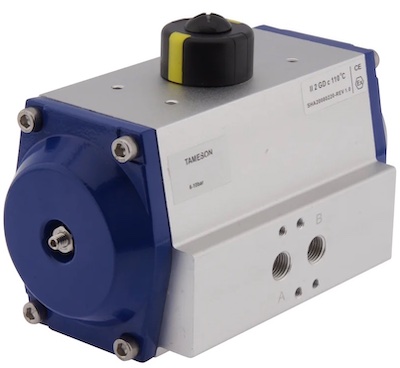
Figure 2: A pneumatic rotary actuator
There are various types of actuators, including pneumatic, hydraulic, electric, magnetic and thermal, and mechanical, each with unique advantages and disadvantages. The type of actuator used in an application depends on the specific requirements of that application, such as the level of force, response time, and durability needed.
- Pneumatic actuators:Pneumatic actuators (Figure 2) use compressed air to generate motion. They can be used for various applications, such as moving machine parts or controlling valve positions. They are often preferred for applications that require high force, fast response times, or explosion-proof environments.
- Hydraulic actuators: Hydraulic actuators use fluid pressure to generate motion. They are commonly used for heavy-duty applications such as construction equipment, manufacturing machinery, and industrial robots. Hydraulic actuators offer high levels of force, durability, and reliability.
Learn more about these two types of actuators in our article that covers the difference between pneumatic and hydraulic cylinders.
- Electric actuators: Electric actuators (Figure 3) use electrical energy to generate motion. They can be driven by AC or DC motors and are often used in applications that require precise control, low noise, and low maintenance. Electric actuators are commonly used in automation systems, medical devices, and laboratory equipment.
- Magnetic and thermal actuators: Magnetic and thermal actuators are two types of actuators that use magnetic and temperature changes to generate motion, respectively. Magnetic actuators use magnetic fields to generate force. Thermal actuators use the expansion or contraction of materials in response to temperature changes. Both actuators are commonly used in micro-electromechanical systems (MEMS) and other miniaturized applications.
- Mechanical actuators: Mechanical actuators use physical mechanisms such as levers, gears, or cams to generate motion. Mechanical actuators are commonly used in applications where low cost, simple operation, and durability are important. Examples include hand-crank machines, manual valve systems, and mechanical locks.
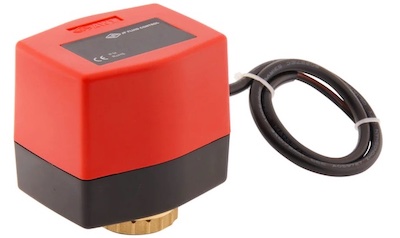
Figure 3: An electric actuator
Applications of actuators
Actuators have a wide range of use in the modern world in machines, automobiles, and automation. The following table describes common applications, devices suitable for said applications, and actuators that provide power to the devices.
Table 1: Applications, devices, and actuators.
| Application | Device | Actuator Type |
| Automated control of fluid flow in pipelines and process systems | Control Valve, Flow Meter | Linear, Rotary (Hydraulic, Electric) |
| Adjustment of industrial valves, positioning of machine components | Ball Valve, Solenoid Valve, Servo Motor | Rotary (Hydraulic, Electric) |
| Digging, grading, and excavating in construction and mining operations | Excavator, Backhoe | Linear, Rotary (Hydraulic) |
| Manufacturing of metal parts, plastic molding, and forging operations | Hydraulic Press, CNC Machine, Forging Hammer | Rotary (Hydraulic, Electric) |
| Powering machine tools, robots, and conveyor systems | Electric Motor, Robot Arm, Conveyor Belt | Linear, Rotary (Electric, Hydraulic) |
| Positioning of machine components in automated production systems | Linear Actuator, Servo Motor, Gripper | Linear, Rotary (Electric, Hydraulic) |
| Regulating the flow of fuel and air into internal combustion engines | Throttle Valve, Fuel Injector | Rotary (Mechanical, Electric) |
| Regulating the speed of steam or gas turbines in power plants | Turbine Governor, Valve | Rotary (Electric, Hydraulic, Thermal) |
| Simple machine control in mechanical systems, such as door openers | Mechanical Lever, Electric Switch | Linear, Rotary (Mechanical, Electric) |
| Transmission of power in machines, such as conveyor systems and gear pumps | Gearbox, Gear Pump, Hydraulic Motor | Linear, Rotary (Hydraulic, Mechanical, Electric) |
FAQs
What is the role of an actuator in a system?
Actuators convert energy into work by responding to a control signal. This results in motion.
What could cause actuators to fail prematurely?
Typically, actuators fail due to application errors like excessive loading, poor mounting fixity, incorrect wiring, and exceeding duty cycle. Such issues can be avoided through a thorough system review and regular maintenance.
Can actuators be repaired?
Actuator failures often occur due to improper use, such as excessive loading, improper mounting, incorrect wiring, or exceeding the recommended duty cycle.
How to test if an actuator is working?
Connect a multimeter in series with one end of the actuator leads. Observe the amp readings while retracting and extending the rod. The readings will indicate the necessary power for the current draw.
What is a valve actuator?
A valve actuator is used to control the opening and closing of the valve.




